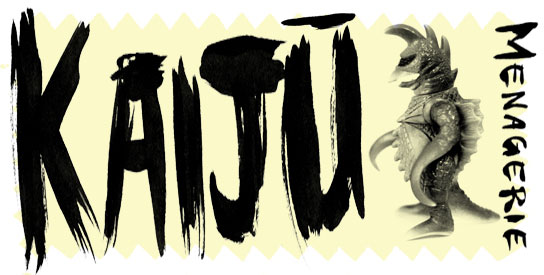
NAME: 
Zigra (ジグラ Jigura)
FIRST APPEARS IN:
Gamera vs. Zigra, 1971
DESIGN FEATURES:
– goblin shark face-mouth
– glowing red eyes
– multi-finned back
SKILLS AND QUIRKS:
– sleeping
– the ability to sprout legs out of nowhere
– being blinded by lights
– verbally threatening Japan
– life goal #1: become the King of the Sea
– being played like a fucking xylophone
MONSTER SOUNDS:
Audio PlayerMy partner walked in as I was watching Gamera vs. Zigra — the last real Shōwa era Gamera sequel (1980’s Gamera: Super Monster is essentially just a greatest hits compilation) — she said, “That monster [Zigra] looks like every other monster in the Gamera series.” I think that’s kind of true. Zigra resembles Gyaos with his pointed head, Viras with his beak, Barugon and Guiron with his sidelined dopey eyes, and he has the same aura of cartoonishness that all Gamera monsters possess.
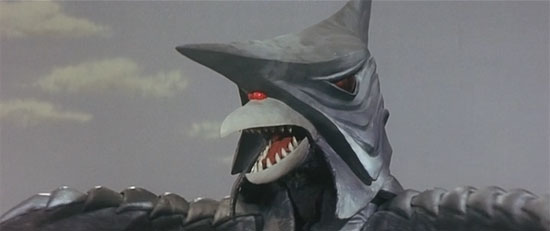
Gamera vs. Zigra is the worst of the Gamera films (again, discounting Gamera: Super Monster). Its child-heroes are infuriating, squawking their lines and constantly being praised by adults (and Zigra, weirdly enough) for their creative child-minds. Never have I wanted so much to see children smacked to smithereens by the tail of a giant monster. Annoying kids aside, there is much to enjoy in Gamera vs. Zigra, including Zigra himself who is, despite his surface similarities to previous monsters, rather unique.
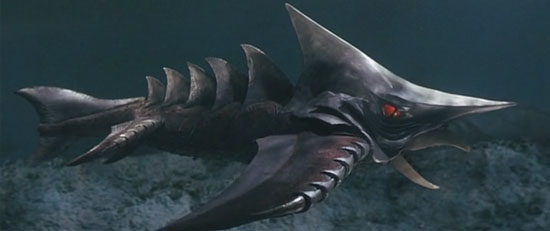
Underwater monsters are a rarity in kaijū films and television. And for good reason. Shooting scenes to resemble an underwater ocean setting, I’d imagine, is difficult, and opportunities for battle are massively limited. Long stretches of underwater action in Gamera vs. Zigra feel like outtakes. Several times, Gamera and Zigra just wobble about next to each other. Zigra also spends an inordinate amount of his time underwater sleeping. When he’s not napping and in motion underwater, Zigra is very effective. Unsurprisingly, like Ultraman’s Gubira, Zigra is dredged from the depths of the ocean for a few fights on land — which seems rather unfair for Zigra.
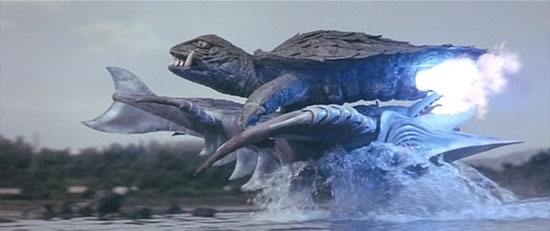
Zigra lacks the flat out weirdness of Guiron, the brutish panache of Gyaos, the creepiness of Jiger, and the rainbow-weaponry of Barugon, but he is still a fun foe, especially in his mad plan to invade Earth. Zigra’s convoluted scheme involves kidnapping a sexy spacewoman from the moon, interrupting radio programs with verbal threats (yes, Zigra can speak — another kaijū rarity), and crowning himself King of the Sea.
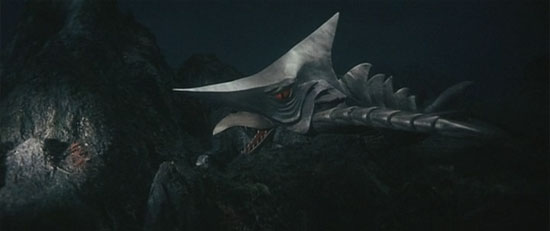
For all his arrogance, Zigra is not much of a threat. The showdown between Gamera and Zigra is one-sided and short-lived. It does, however, scores points for being utterly hysterical. Gamera weakly throws a rock at Zigra — a rock that slowly, painfully slowly, make its way through the air and softly impales itself on Zigra’s beak. It also features what has to be one of the most humiliating moments in monster fighting history (perhaps second only to Jiger’s fucked up impregnation of Gamera): Gamera plays Zigra’s fins like a xylophone as Zigra flaps around hopefully and is laughed at by onlookers. Wow.
Gamera vs. Zigra is not going to impress hardened kaijū viewers, nor is it a good introduction for kaijū virgins. But with my love of shark cinema, I can help but love Zigra’s fishy design, and the film’s underwater sequences. Gamera vs. Zigra may be the worst of the Gamera films, but it is still very entertaining, which is more than I can say for the worst of the Godzilla films. No offense, big guy.




